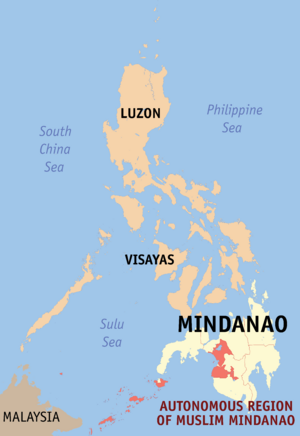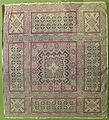Autonomous Region in Muslim Mindanao facts for kids
Quick facts for kids Autonomous Region in Muslim Mindanao (ARMM)
|
|||||||||||
|---|---|---|---|---|---|---|---|---|---|---|---|
| Former autonomous region of the Philippines | |||||||||||
| 1989–2019 | |||||||||||
 Location within the Philippines |
|||||||||||
| Capital | Cotabato City (provisional and de facto seat of government) Parang (de jure seat of government, 1995–2001) |
||||||||||
| Population | |||||||||||
|
• 2015
|
3,781,387 | ||||||||||
| History | |||||||||||
|
• Established
|
1 August 1989 | ||||||||||
|
• Turnover of ARMM to BARMM
|
26 February 2019 | ||||||||||
| Political subdivisions | |||||||||||
|
|||||||||||
| Today part of | Bangsamoro Autonomous Region | ||||||||||
The Autonomous Region in Muslim Mindanao was an autonomous region of the Philippines. It was in the Mindanao island group of the Philippines.
There were 5 provinces: Basilan (except Isabela City), Lanao del Sur, Maguindanao, Sulu, and Tawi-Tawi. It was the only region that had its own government.
Images for kids
-
Daru Jambangan (Palace of Flowers) in Maimbung, Sulu before it was destroyed by a typhoon in 1932.
-
Tausūg horsemen in Sulu, taken on December 30, 1899.
-
Pastil, a traditional Maguindanaon food.
See also
 In Spanish: Mindanao Musulmán para niños
In Spanish: Mindanao Musulmán para niños

All content from Kiddle encyclopedia articles (including the article images and facts) can be freely used under Attribution-ShareAlike license, unless stated otherwise. Cite this article:
Autonomous Region in Muslim Mindanao Facts for Kids. Kiddle Encyclopedia.






















